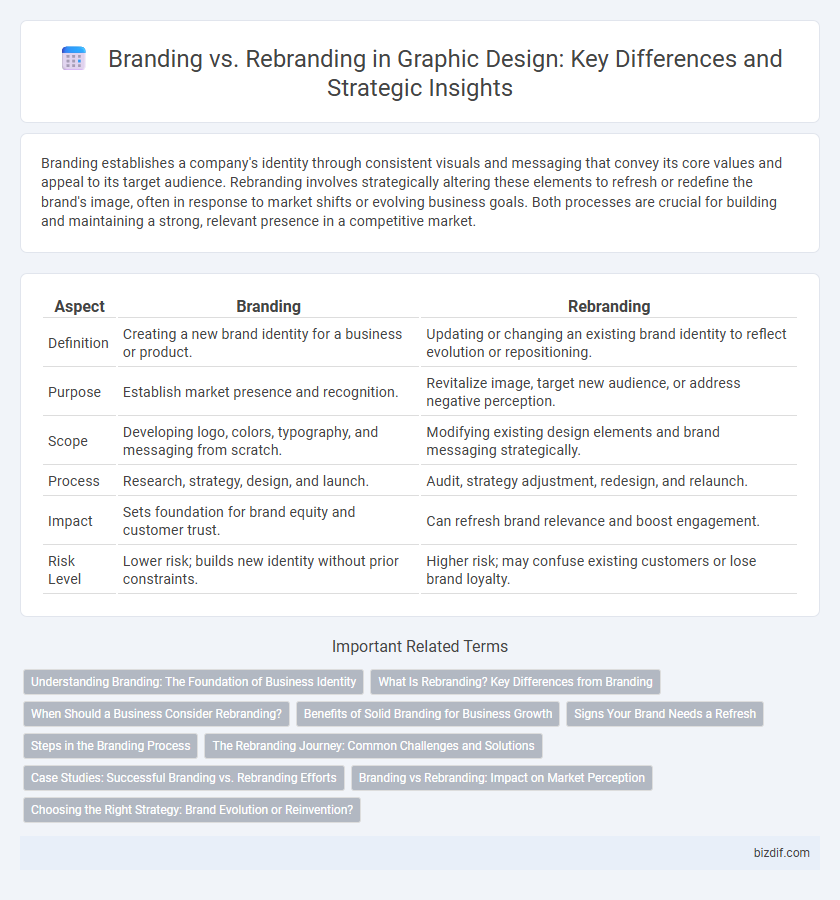Branding establishes a company's identity through consistent visuals and messaging that convey its core values and appeal to its target audience. Rebranding involves strategically altering these elements to refresh or redefine the brand's image, often in response to market shifts or evolving business goals. Both processes are crucial for building and maintaining a strong, relevant presence in a competitive market.
Table of Comparison
| Aspect | Branding | Rebranding |
|---|---|---|
| Definition | Creating a new brand identity for a business or product. | Updating or changing an existing brand identity to reflect evolution or repositioning. |
| Purpose | Establish market presence and recognition. | Revitalize image, target new audience, or address negative perception. |
| Scope | Developing logo, colors, typography, and messaging from scratch. | Modifying existing design elements and brand messaging strategically. |
| Process | Research, strategy, design, and launch. | Audit, strategy adjustment, redesign, and relaunch. |
| Impact | Sets foundation for brand equity and customer trust. | Can refresh brand relevance and boost engagement. |
| Risk Level | Lower risk; builds new identity without prior constraints. | Higher risk; may confuse existing customers or lose brand loyalty. |
Understanding Branding: The Foundation of Business Identity
Branding establishes a company's core identity by defining its visual elements, messaging, and overall perception in the market. A consistent brand builds trust, differentiates from competitors, and fosters customer loyalty by conveying the business's values and mission. Understanding branding as the foundation ensures that every design decision supports a cohesive and memorable brand experience.
What Is Rebranding? Key Differences from Branding
Rebranding involves changing an existing brand's identity, including its logo, design, and messaging, to reposition the company in the market or appeal to a new audience. Unlike branding, which establishes a brand from scratch, rebranding modifies or updates an established brand to reflect new values, products, or market conditions. Key differences include the scope of change, with branding creating a fresh identity and rebranding transforming an existing perception to maintain relevance and competitive advantage.
When Should a Business Consider Rebranding?
Businesses should consider rebranding when their current brand no longer aligns with evolving market trends, target audiences, or company values. Indicators include significant shifts in industry competition, outdated visual identity, or negative brand perception affecting customer engagement. Rebranding revitalizes market positioning, enhances brand relevance, and supports long-term growth strategies in dynamic market environments.
Benefits of Solid Branding for Business Growth
Solid branding establishes a consistent visual identity and voice that enhances customer recognition and trust, driving long-term loyalty and increasing market share. Effective branding differentiates businesses from competitors, enabling premium pricing and stronger emotional connections with target audiences. Strong brand equity supports business growth by attracting new customers, facilitating product launches, and improving overall corporate reputation.
Signs Your Brand Needs a Refresh
A brand needs a refresh when its visual identity becomes outdated, failing to connect with current target audiences or reflect company values. Signs include declining customer engagement, inconsistent messaging across platforms, and a noticeable drop in market competitiveness. Refreshing branding elements such as logos, color schemes, and typography can revitalize market presence and strengthen brand recognition.
Steps in the Branding Process
The branding process involves defining the brand's core values, target audience, and unique selling proposition to create a consistent visual identity and messaging strategy. Key steps include market research, logo design, brand voice development, and implementation across all marketing channels. Rebranding requires revisiting these steps with an emphasis on analyzing existing brand perceptions and strategically adjusting elements to better align with evolving business goals.
The Rebranding Journey: Common Challenges and Solutions
The rebranding journey often encounters challenges such as audience alienation, inconsistent messaging, and budget constraints that can disrupt brand recognition and loyalty. Effective solutions include thorough market research to realign brand identity with target demographics, phased rollout strategies to maintain customer engagement, and cross-channel consistency to reinforce the new brand image. Leveraging expert graphic design principles ensures a cohesive visual transformation that supports long-term brand equity growth.
Case Studies: Successful Branding vs. Rebranding Efforts
Case studies in graphic design reveal distinct outcomes of branding versus rebranding; Coca-Cola's consistent branding strategy maintained global recognition and customer loyalty, while Airbnb's 2014 rebranding successfully repositioned the company with a modern, user-friendly identity that boosted market presence. Successful branding efforts often hinge on establishing a clear, memorable visual identity consistent across all platforms, exemplified by Apple's minimalist design philosophy. In contrast, effective rebranding requires a strategic overhaul to address shifting market demands or company evolution, as demonstrated by Old Spice's transformation from an outdated image to a vibrant, youthful brand through bold graphic design changes.
Branding vs Rebranding: Impact on Market Perception
Branding establishes a unique identity that cultivates customer trust and loyalty, positively influencing market perception through consistent messaging and visual elements. Rebranding involves significant changes to a company's brand identity, which can refresh market perception but also risk confusing existing customers if not executed strategically. Both processes critically affect how consumers perceive value, credibility, and relevance in competitive markets.
Choosing the Right Strategy: Brand Evolution or Reinvention?
Choosing the right strategy between branding and rebranding hinges on whether a company seeks brand evolution or reinvention to align with market shifts and audience expectations. Brand evolution involves refining existing elements like logo design, color schemes, and brand messaging to enhance recognition while maintaining core identity. Rebranding requires a comprehensive overhaul of visual identity, tone, and positioning to break away from outdated perceptions and capture new market opportunities in graphic design.
Branding vs Rebranding Infographic

 bizdif.com
bizdif.com